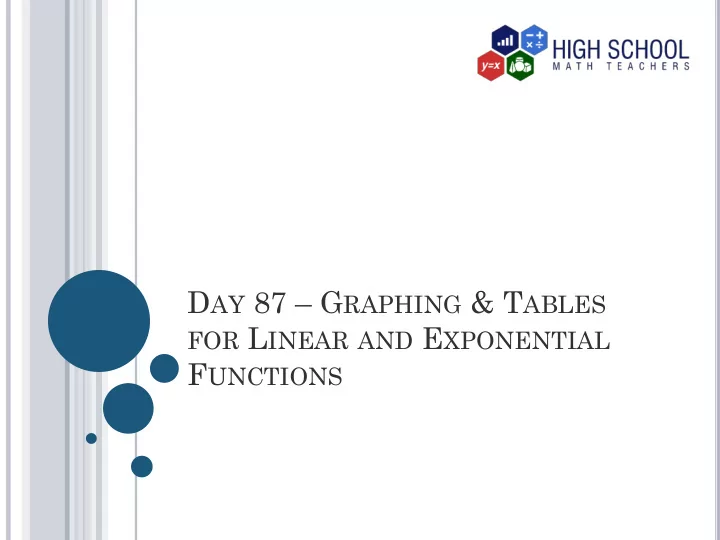

D AY 87 – G RAPHING & T ABLES FOR L INEAR AND E XPONENTIAL F UNCTIONS
E XPLORING E XPONENTIAL G ROWTH AND D ECAY Teacher Notes Overview: Students explore exponential growth and decay with a paper- folding activity and yarn-cutting activity. Objective: Students will work in pairs to collect data, explore patterns in their collected data, and find exponential models that represent their data. They will display their findings graphically. Materials Needed: Paper (one sheet for each pair of students) Yarn (one piece, about 1 yard, for each pair of students) Calculator Graph Paper Rulers Scissors
A CTIVITY 1.Students work in pairs on the exponential growth activity, following the directions on the activity sheet. (One group of 3 may be necessary.) 2.After the students complete the exponential growth activity, the teacher should lead a discussion of questions 4 – 7.
3.After completing the exponential growth activity, the students should work on the exponential decay activity, following the directions on the activity sheet. 4. After the students complete the exponential decay activity, the teacher should lead a discussion of questions 3 – 6.
P APER -F OLDING A CTIVITY Part 1 1)Look at your sheet of paper and determine the number of “sections” the paper has when it is completely unfolded. Record this data in the table below. 2)Fold your piece of paper in half and determine the number of sections the paper has after you have made a fold. Record this data in the table below.
3)Fold the piece of paper in half again and determine the new number of sections. Record your data in the table. Continue in the same manner, folding the paper and recording the data, until it becomes too hard to fold the paper any more. (This will probably happen around the 6 th fold.) Paper-Folding Data Number of Number of Folds Sections
3)Fold the piece of paper in half again and determine the new number of sections. Record your data in the table. Continue in the same manner, folding the paper and recording the data, until it becomes too hard to fold the paper any more. (This will probably happen around the 6 th fold.) Paper-Folding Data Number of Number of Folds Sections 0 1 1 2 2 4 3 8 4 16 5 32 6 64 7 128
4)Which column of your table is the input? Which column is the output? 5)Using graph paper, make a scatter plot of the data.
4)Which column of your table is the input? Which column is the output? input-folds, output-sections 5)Using graph paper, make a scatter plot of the data. 0.60 0.50 0.40 0.30 0.20 0.10 0.00 0 2 4 6 8
6)By studying the graph and/or table, predict what you think the number of sections will be for 10 folds. 7)Determine a mathematical model (equation) that represents this data by examining the patterns in the table.
6)By studying the graph and/or table, predict what you think the number of sections will be for 10 folds. 2 10 = 1024 7)Determine a mathematical model (equation) that represents this data by examining the patterns in the table. y= 2 x
Y ARN -C UTTING A CTIVITY Part II 1)Begin with one piece of yarn and consider it to be one unit long. This data is recorded in the table below. 2)Fold your piece of yarn in half and cut it. You should now have two pieces of yarn, each half the length of the original piece. This information has also been recorded for you in the table below.
3)Continue in the same manner, cutting each piece of yarn in half and recording the new number of pieces and new length, until it becomes too hard to cut the yarn. (This will probably happen around the 5 th cut.) Be sure to record your data in the table. Yarn-Cutting Data Number of Length of Each New Piece Pieces 1 1 2 1/2
3)Continue in the same manner, cutting each piece of yarn in half and recording the new number of pieces and new length, until it becomes too hard to cut the yarn. (This will probably happen around the 5 th cut.) Be sure to record your data in the table. Yarn-Cutting Data Number of Length of Each New Piece Pieces 1 1 2 1/2 3 1/4 4 1/8 5 1/16 6 1/32 8 1/64 7 1/128
4)Which column of your table is the input? Which column is the output? 5)Using graph paper, make a scatter plot of the data.
4)Which column of your table is the input? Which column is the output? Input – number of pieces, output-length 5)Using graph paper, make a scatter plot of the data. 0.60 0.50 0.40 0.30 0.20 0.10 0.00 0 1 2 3 4 5 6 7 8
6)By studying the graph and/or table, predict what you think the length of each new piece will be after the 10th cut. 7) Determine a mathematical model (equation) that represents this data by examining the patterns in the table.
6)By studying the graph and/or table, predict what you think the length of each new piece will be after the 10th cut. 1 1024 7) Determine a mathematical model (equation) that represents this data by examining the patterns in the table. 1 y x 2
Recommend
More recommend